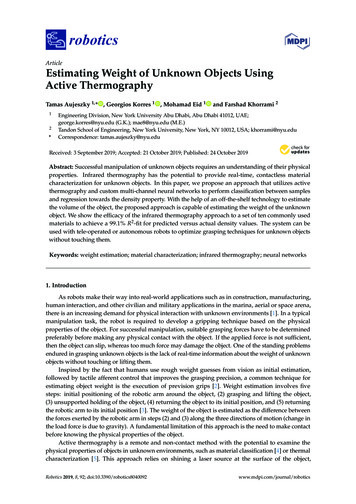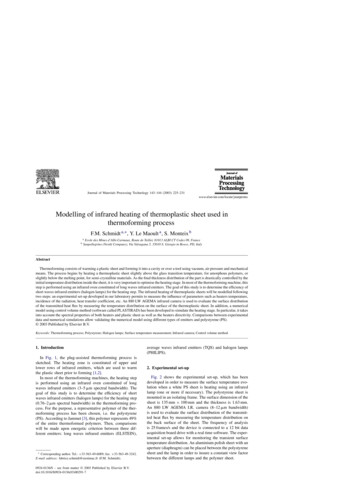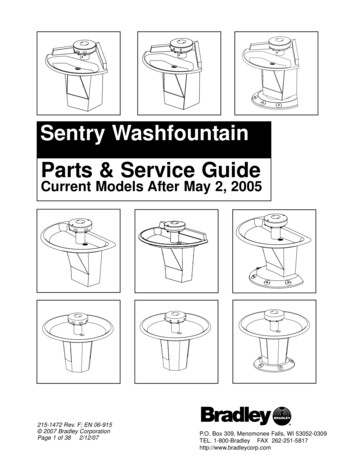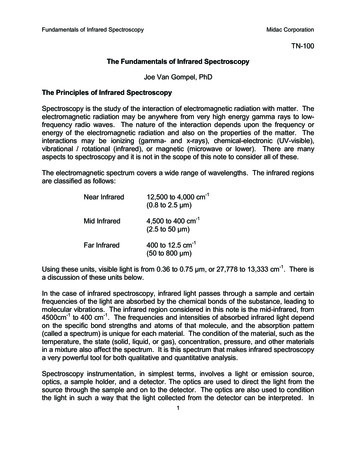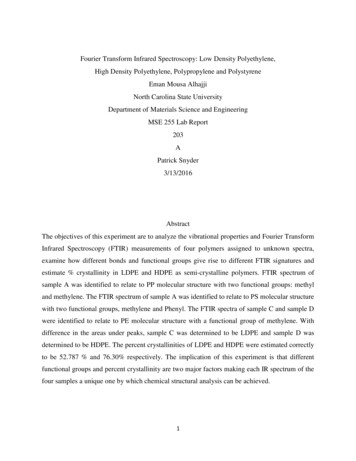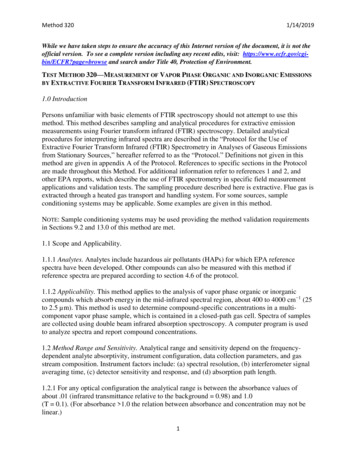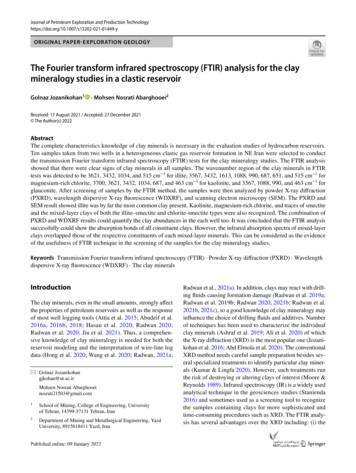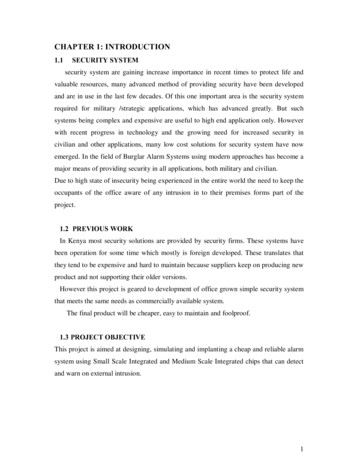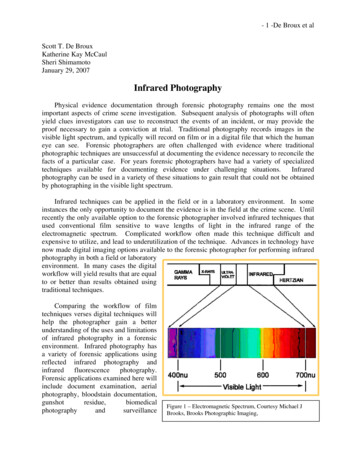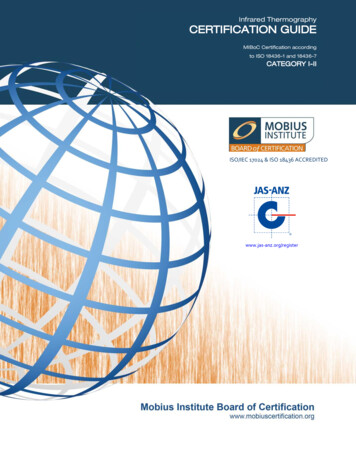
Transcription
Infrared ThermographyCERTIFICATION GUIDEMIBoC Certification accordingto ISO 18436-1 and 18436-7CATEGORY I-IIISO/IEC 17024 & ISO 18436 ACCREDITED
MOBIUS INSTITUTEE-MAIL Sales & General Questions: office@mobiuscertification.orgCertification: certification@mobiuscertification.orgTechnical Support: technical@mobiuscertification.orgTELEPHONE: Toll Free (North America): (877) 550-3400Worldwide: ( 1) 615-216-4811 or ( 61) obius Institute Board of Certification1525 Frankston-Flinders Road, TyabbVictoria, 3913AUSTRALIAVersion: 4 – Issued: 11 June 2021 2021 – Mobius Institute – All rights reserved.ED139-IRT v4Issued: 11 June 2021Page 1 of 16This document is uncontrolled when downloaded or printed.
WelcomeThank you for your interest in Mobius Institute Board of Certification (MIBoC), an ISO/IEC accreditedcertification body having certified condition monitoring personnel from over 100 countries. MIBoCcertification is delivered through MIBoC authorized examination centers in over 50 countries. See theMIBoC website at www.mobiuscertification.org to locate an authorized examination center near you.In addition to receiving your certification through a MIBoC examination center, you also have theconvenient option to sit your certification examination at a time and location of your choice using oursecure online examination software.When considering your infrared thermography certification provider, you must be assured that thecertification does meet the ISO 18436 specification that all thermographers are measured to. Manyequipment vendors, consultants and training organizations offer thermography training andcertification. Many will advertise that they their training and certification “follows the ISO 18436standard”, but those not accredited may or may not actually provide you the competency intended bythe ISO 18436 standard. Only accredited organizations can and do provide the highest level ofrecognition associated with the certifying body’s accreditation. Mobius Institute Board of Certificationis accredited to ISO/IEC 17024 and ISO 18436-1 by an accredited IAF member organization, to ensurethe certification program minimally meet the ISO 18436 specification. IAF organizations include JointAccreditation System of Australia and New Zealand (JAS-ANZ), American National Standards Institute(ANSI) and the United Kingdom Accreditation Services (UKAS).Getting StartedMIBoC is here to help you. We have friendly and knowledgeable staff that will guide you along yourway through your thermography certification. Never hesitate to contact us with your questions.Because we serve customers through all world time zones, it is best to contact us by email atcertification@mobiuscertification.org and we will respond promptly with email.Thank youWe hope that this Certification Guide provides you a good understanding of what thermographycertification is all about. If you have any further questions, please don’t hesitate to contact us.We wish you the greatest success as you educate yourself and become a certified thermographer.ED139-IRT v4Issued: 11 June 2021Page 2 of 16This document is uncontrolled when downloaded or printed.
Table of ContentsWelcome. 2Getting Started . 2Thank you. 2Introduction . 4MIBoC’s Thermography Roadmap . 4Category I Thermography . 4Category II Thermography. 4About MIBoC . 5Committees. 5Governing Body . 5Scheme Committee . 5Technical Committee . 6MIBoC’s Certification Scheme . 6Benefits of MIBoC Certification . 6Thermography Certification Requirements . 7Education . 7Training . 8Examination . 8Experience & previous certification . 8Code of Ethics . 9Certification Exam . 9Examination Development Process . 10How to apply for an exam . 10Reporting of Results . 10Special Consideration . 11Distribution of Certificates . 11Appeals & Complaints . 11Exam Resits . 11Renewal & Re-certification . 12References . 12Appendix A – Body of Knowledge . 13ED139-IRT v4Issued: 11 June 2021Page 3 of 16This document is uncontrolled when downloaded or printed.
IntroductionThis Certification Guide has been written to provide the reader with the essential information, inlayman’s terms, about the infrared thermography certification scheme of the Mobius Institute Board ofCertification.It contains information about MIBoC’s certification scheme, which is accredited by the JointAccreditation System of Australia and New Zealand (JAS-ANZ). It is therefore internationallyrecognized and accredited at the same level as organizations which are accredited by the AmericanNational Standards Institute (ANSI) and the United Kingdom Accreditation Services (UKAS).This guide also outlines a roadmap of MIBoC thermography certification, as well as the benefits whichcertification brings, and the requirements that need to be fulfilled to become certified.This guide should be read in conjunction with the scheme documents, particularly the General SchemeRequirements (ED002) and the Thermography Scheme Requirements (ED133). These documents canbe downloaded from the MIBoC website at www.mobiuscertification.org.MIBoC’s Thermography RoadmapMIBoC’s scheme covers thermography certification for Category I and Category II. Our classification ofthe thermography categories is based on those outlined in standard ISO 18436-7.Thermographers who are certified through MIBoC should be justifiably proud of their achievements.Category I ThermographyThermographers certified to Category I will have a good understanding of the fundamentals. They arequalified to perform infrared thermography according to established and recognized procedures. Theywill also be able to set up and operate thermal imaging equipment for safe datacollection, perform basic fault detection, severity assessment and diagnoses andperform basic image post-processing. They will be able to maintain a database ofresults as well as evaluate and report test results.Category II ThermographyIn addition to having to knowledge and capability of a Category I thermographer, a Category IIthermographer is able to select and apply thermographic theory and techniques, includingmeasurement and interpretation of survey results. Additionally, they are able to perform advancedfault diagnosis and recommend appropriate field corrective actions and performadvanced image post-processing. They can prepare reports on equipmentcondition, fault diagnoses, corrective actions and effectiveness of repairs andthey will be aware of the use of alternative or supplementary conditionmonitoring technologies.ED139-IRT v4Issued: 11 June 2021Page 4 of 16This document is uncontrolled when downloaded or printed.
About MIBoCMobius Institute began certifying Vibration Analysts in 2005.The Mobius Institute Board of Certification (MIBoC) was formed in 2011 to provide independent andimpartial certification for personnel involved in condition monitoring and diagnostics of machines.In 2017 MIBoC expanded its certification scheme to include Infrared Thermography and Ultrasound.MIBoC’s aim is to provide access to condition monitoring certification around the world, and in as manylanguages as possible. We believe that if an analyst wants to become certified, he or she should not beimpeded by location, language or socio-economic situation.In 2012 MIBoC was formally accredited by the Joint Accreditation System of Australia and New Zealand(JAS-ANZ) to the international standard ISO/IEC 17024 to provide personnel certification in thecondition monitoring field.JAS-ANZ has formal arrangements with a number of international accreditationorganizations including the International Accreditation Forum (IAF), the PacificAccreditation Cooperation (PAC), the Asia Pacific Laboratory AccreditationCooperation, and the European cooperation for Accreditation (EA).Other IAF member organizations include ANSI in the United States, SAS inSwitzerland and UK AS in the United Kingdom.www.jas-anz.org/registerThis means that certification through MIBoC is recognized internationally.CommitteesThe activities and strategic direction of the Mobius Institute Board of Certification are governed by amanagement team and a number of committees which collectively represent the scheme’sstakeholders.Governing BodyThe remit of the Governing Body is to ensure that the activities of the MIBoC Board, management teamand committees meet the needs of the condition monitoring community, including employers, clients,vendors and training companies. Additionally, it is responsible for safeguarding the independence andimpartiality of MIBoC at all levels, including its organizational structure, policies and procedures.Scheme CommitteeMIBoC’s scheme committee is responsible for the development, review and approval of theorganization’s policies and procedures.Members of the scheme committee represent stakeholders at a number of different levels, includingcondition monitoring functionality, industry and geographical region.ED139-IRT v4Issued: 11 June 2021Page 5 of 16This document is uncontrolled when downloaded or printed.
Technical CommitteeMIBoC has established separate Technical Committees for each of the condition monitoringtechnologies in its certification scheme: Vibration Analysis, Thermography and Ultrasound.Members of MIBoC’s Technical Committees provide expertise on the technical aspects of thecertification scheme, including the development, review and approval of the examination questions,the review and approval of training courses and certifications from other organizations,providing an escalation point for technical decisions relating to certification, appeals andcomplaints.MIBoC’s Certification SchemeThe infrared thermography certification program of the Mobius Institute Board of Certification isaccredited to and based on the requirements of international standards ISO/IEC 17024, ISO 18426-1 andISO 18436-7: ISO/IEC 17024 is the ISO standard which outlines how personnel certification programs shouldbe conducted in general.ISO 18436-1 is the ISO standard which outlines how personnel certification should beconducted specifically for personnel engaged in Condition Monitoring and Diagnostics ofMachines.ISO 18436-7 is the ISO standard which outlines the technical requirements that are specific tocertification of Thermography personnel.MIBoC’s policies, processes and procedures are reviewed and approved by its committees to ensurethat they are impartial and meet the needs of the various stakeholder groups. The certificationprogram is reviewed regularly and updated when necessary to reflect changes in the ISO standards orrequirements of industry.Benefits of MIBoC CertificationCertification is required by many employers, and a growing list of companies will not use consultantsthat have not been certified.Certification by Mobius Institute Board of Certification is the most highly recognized certificationavailable anywhere. MIBoC is recognized as certifying practical condition monitoring personnel, notjust people with good memorization skills.You do not need to be trained by Mobius Institute to obtain MIBoC certification. As long as you meetthe training requirements outlined in this Guide (along with the other certification requirements), youwill be eligible to apply for MIBoC certification.ED139-IRT v4Issued: 11 June 2021Page 6 of 16This document is uncontrolled when downloaded or printed.
We do not charge annual fees to maintain your certification. Once you have obtained your certification,you will not need to pay anything further until its expiry date when you may wish to renew it.When you are certified by MIBoC you will receive a digital certificate and card as evidence of yourqualification. You will also receive your own personalized certification logo, and (if you consent) yourname will be displayed on our website’s list of certified analysts.Thermography Certification RequirementsAs per the requirements of ISO 18436-7, in addition to passing the certification exam, candidates forcertification need to have a combination of education, training, and experience to ensure theyunderstand the principles and procedures which apply to infrared thermography.Additionally, it is required that all candidates have their colour perception assessed by the Ishihara 24plate test. A record of test results should be retained and presented to the MIBoC upon request. In theevent that a colour perception deficiency, indicated by misreading four or more of the 24 plates, isdetected during the Ishihara test, a secondary colour shade perception test shall be administered byMIBoC to assess the candidate's ability to differentiate between shades of colours. Failure of both theIshihara and the secondary test will result in conditional certification being issued (assuming all othercertification requirement are met), noting that a colour perception deficiency may exist.EducationWhist candidates do not need to provide evidence of any formal education; it is recommended thatcandidates for Category I and II have at least secondary school graduation diploma or its equivalent.Category II and III candidates must be able to manipulate simple algebraic equations, use a basicscientific calculator and be familiar with the operation of personal computers.ED139-IRT v4Issued: 11 June 2021Page 7 of 16This document is uncontrolled when downloaded or printed.
For Category III candidates it is highly recommended that they have successfully completed two ormore years of mechanical technology or mechanical engineering at an accredited college, university ortechnical school.TrainingTo be eligible to apply for certification, candidates need to provide evidence of successful completion(such as a Certificate of Attendance) of formal training conforming to the requirements of ISO 18436-3(Condition monitoring and diagnostics of machines – Requirements for qualification assessment ofpersonnel – Part 3: Requirements of training bodies and the training process) and based on the Body ofKnowledge specified in Annex A. The minimum training hours are specified in Table 1 below.Table 1 – Minimum training (hours)Category I32Category II32MIBoC recognizes a number of training courses as meeting the training requirements for certification.For a complete list of recognized courses, please refer to document ED144, which can be downloadedfrom our website.If you have attended a course which covers the required topics outlined in the Body of Knowledgespecified in Appendix A but is not listed as a recognized course in ED144, then you can still apply tohave your training recognized by sending us details of the course and training provider, using formED041.In addition to the training hours shown in Table 1, candidates should attend machinery and componenttraining, or equivalent on-the-job training, of at least a similar duration to that specified in Table 1. Ifundertaken, the additional training should cover the design, manufacturing, installation, operation andmaintenance principles of machines and components, the failure modes and mechanisms associatedwith each principle, and the typical thermodynamic behaviours associated with each mechanism.ExaminationTo be eligible for certification, candidates must pass the MIBoC thermography certificationexamination. As per ISO 18436-7, the required pass mark is 75%.For more details of the exam, please refer to the Certification Examination section below.Experience & previous certificationCandidates must provide evidence of their practical work experience in the field of thermographybased machinery condition monitoring and diagnostics. The breadth and depth of the experience isexpected to be in line with the category being applied for (refer Classification of ThermographyCategories section above).ED139-IRT v4Issued: 11 June 2021Page 8 of 16This document is uncontrolled when downloaded or printed.
Candidates will be asked to provide the contact details of a manager/supervisor who can verify the workexperience details submitted by the candidate.The minimum experience requirements are shown in Table 2 below.Table 2 – Minimum experience (months)Category ICategory II1224Note: the experience months are based on 16hours per month of thermography-basedmachinery condition monitoring experience.Certification at Category II requires previous certification at the lower category.Candidates applying for certification at Category II only, who have at least 60 months of verifiablethermography work experience, may apply as mature candidates, allowing them to bypass (at MIBoC’sdiscretion) the requirement of have obtained previous certification at Category I.Code of EthicsCandidates certified by MIBoC are expected to maintain the highest standards of personal integrity,professional competence and ethical principles, and will be required to agree to a Code of Ethics as partof their registration in our online Training Management System (TMS).Certification ExamMIBoC certification examinations consist of a number of multiple-choice questions, selected fromMIBoC’s exam question database. The content is based on the Body of Knowledge specified in AnnexA. The questions are of a practical nature, yet test the candidate on the concepts and principlesrequired to conduct infrared thermography. They may involve the interpretation of charts and plots.Simple mathematical calculations using a basic scientific calculator are required; a summary ofcommon formulae will be provided with the exam questions.The duration and the number of questions in MIBoC’s certification examinations are outlined in Table 3below.ED139-IRT v4Issued: 11 June 2021Page 9 of 16This document is uncontrolled when downloaded or printed.
Table 3 –Specifications of certification examinations by categoryCategory ICategory II General sector moduleSupplementary examNumber of Questions5060 (30 30)Exam Duration (hours)22301Examination Development ProcessMIBoC’s certification examinations are developed and reviewed using a rigorous psychometric analysisprocess to ensure the fairness and validity of each exam.The examination specification is based on the requirements of ISO 18436-7. All questions are reviewedby members of the Thermography Technical Committee to ensure they are fair, accurate andappropriate to the category.Additionally, detailed analysis is carried out on the way the exam questions are answered by candidatesto identify any potential anomalies or outliers.How to apply for an examCandidates may sit a certification examination at one of MIBoC’s many Authorized ExaminationCenters (AECs) around the world. You will find a list of AECs and their contact details on our website.If you are unable to get to an AEC location you may take the exam using our invigilation process, whichallows you to take the exam at a date and location of your choice, supervised by an invigilator or proctornominated by you. The invigilator must be someone who is independent and has no involvement orbackground in condition monitoring or reliability-based maintenance in any manner. Examples includea Human Resource Representative, Training Coordinator, University or Community College examcenter.Invigilated exams may be taken in either a paper-based format or an online internet-based format.To apply for an invigilated exam, please contact exams@mobiusinstitute.com.Reporting of ResultsExamination results are e-mailed directly to the candidate around 10-14 days after the examination isreceived at MIBoC’s Australian office. Candidates will receive a score range indicating theirperformance in each of the sections on the exam, as well as an overall score range and a Pass/Fail result.Due to Privacy Regulations, regardless of who paid for the certification application, results will be madeavailable only to the candidate themselves. However, if the candidate consents, the exam score rangewill also be made available to the candidate’s AEC where the exam was taken.ED139-IRT v4Issued: 11 June 2021Page 10 of 16This document is uncontrolled when downloaded or printed.
Special ConsiderationCandidates may apply for accommodation of special needs, e.g. conditions which may require someform of consideration or compensation, such as language or disabilities. An example of compensationcould be extended time for the candidate to complete the exam.Accommodation for special needs is granted at MIBoC’s discretion and candidates may apply usingform ED033 which can be downloaded from our website.Distribution of CertificatesCertificates and certification cards are issued digitally to successful candidates, who are notified byemail. Issuing of digital certificates usually occurs around 2-4 weeks after the examination results aresent to the candidate.Candidates may opt to additionally receive a printed hardcopy of the certificate and card; applicationsshould be made through the Mobius Institute webstore.Appeals & ComplaintsCandidates or other parties may lodge a complaint or appeal.A complaint is typically a criticism of MIBoC’s policies/procedures or how these were carried out byMIBoC or an AEC.An appeal can be lodged against a failure by MIBoC to certify, renew or re-certify a candidate, oragainst a decision by MIBoC to withdraw or cancel a candidate’s certification.Details of the Appeals/Complaints process can be found on form ED007 which can be downloaded fromour website.Exam ResitsIn the event that a candidate is unsuccessful in passing the certification examination, he/she can applyto re-sit the exam twice, provided that the re-sit takes place no sooner than 30 days after the previousexam date.A candidate who fails three consecutive attempts will be excluded from further examinations for aperiod of 12 months.ED139-IRT v4Issued: 11 June 2021Page 11 of 16This document is uncontrolled when downloaded or printed.
Renewal & Re-certificationThe period of certification is 5 years. Within 6 months of the certification expiry date the candidate isable to apply to renew the certification for a further 5 years provided he/she can provide evidence ofcontinued work experience in the field of thermography for the previous five years without significantinterruption.Significant Interruption is defined as an absence from (or change of) work activity which prevents theholder of MIBoC certification from practicing the duties corresponding to the scope of the certificationfor a continuous period in excess of 365 days, or a number of periods exceeding two years.NOTE: Legal holidays, or periods of sickness or courses of less than thirty days are not taken into accountwhen calculating the interruption.Certified analysts will be invited by e-mail (using the e-mail address specified by the candidate in thestudent database) to renew their certification.Renewal applications should be made in writing using form ED036 and accompanied by ED034, both ofwhich can be downloaded from our website.ReferencesThe following ISO standards can be obtained from the International Standards Organization Store athttp://www.iso.org/iso/home/store.htm. ISO/IEC 17024 - Conformity assessment — General requirements for bodies operatingcertification of personsISO 18436-1 - Condition monitoring and diagnostics of machines — Requirements for trainingand certification of personnel - Part 1: Requirements for certifying bodies and the certificationprocessISO 18436-3 - Condition monitoring and diagnostics of machines — Requirements for trainingand certification of personnel - Part 3: Requirements for training bodiesISO 18436-7:2014 - Condition monitoring and diagnostics of machines — Requirements fortraining and certification of personnel - Part 7: ThermographyED139-IRT v4Issued: 11 June 2021Page 12 of 16This document is uncontrolled when downloaded or printed.
Appendix A – Body of KnowledgeSubjectTopics0. IntroductionContext of condition monitoring versusNDT, overviews of intent behind topics,and explanation of personnelclassification categories1. Principles of infrared thermographyCATICATII0.5-67Heat and heat transfer*Conduction fundamentals*Fourier’s Law*Conductivity/resistance*Convection fundamentals*Newton’s Law of Cooling*Radiation Fundamentals*Electromagnetic spectrum*Atmospheric transmission*IR wavebands and lens materials*Radiation reference sources*Planck’s Law*Wien’s Law*Stefan-Boltzmann LawEmmitance, reflectance andtransmittanceEmissivityFactors affecting emissivity2. Equipment and data acquisitionHow your infrared camera works******53*Infrared camera selection criteria*Spectral band*Temperature measurement range*Thermal sensitivity (NETD)**Lens selection**Optical resolution**Operation of equipment**Accessories**ED139-IRT v4Issued: 11 June 2021*Page 13 of 16This document is uncontrolled when downloaded or printed.
SubjectTopicsCATIICamera controls*ISO 18434-1**Safe data acquisition**Getting a good image*Image composition*Image clarity (optical focus)*Thermal tuning (range, level and span)*Palette selection*Emissivity determination****Error source recognition, prevention orcontrolWaveband selection criteriaRecognizing and dealing with radiation(reflections, reflected apparenttemperature)Recognizing and dealing with convectionRecognizing and dealing withconductionEffects of EmissivityCamera calibrationEnvironmental and operationalconditionsData and image storage3. Image processing***************62Temperature measurement**ISO 18434-1**Non-contact thermography*Comparative quantitative thermography**Comparative qualitative thermography**Environmental influences**Camera measurement tools**Measurement tools**Palette selection*Level and span adjustment*Distance (atmospheric) correction**Emissivity correction*Statistical analysis*ED139-IRT v4Issued: 11 June 2021CATIPage 14 of 16This document is uncontrolled when downloaded or printed.
SubjectTopicsCATIImage subtraction*Image montage**Temperature trending**General image interpretation guidelines**General guidelines for establishingthermal severity assessment criteria(ISO 18434-1, engineering codes andstandards)4. General applicationsDiscussion on general industrialapplicationsActive and passive thermography5. Diagnostics and prognosticsBasic principles of diagnostics (ISO13379)Basic principles of prognostics (ISO13381-1)6. Condition
Other IAF member organizations include ANSI in the United States, SAS in Switzerland and UK AS in the United Kingdom. This means that certification through MIBoC is recognized internationally. Committees The activities and strategic direction of the Mobius Institute Board of Certification are governed by a
